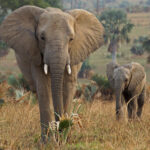The African wattled Lapwing in Uganda; is a familiar farmland bird, especially in lowland areas. In breeding season it prefer spring-sown cereals, root crops, permanent unimproved pasture, meadows and fallow fields. It’s also found in wetlands with short vegetation. In winter lapwings flock on pasture and ploughed fields.
These are conspicuous and unmistakable birds. They are large brown waders with a black crown, white forehead and large yellow facial wattles. The tail is white, tipped black, and the long legs are yellow.
In flight, African Wattled Lapwings’ upper wings have black flight feathers and brown coverts separated by a white bar. The under wings are white with black flight feathers.
The African wattled lapwing (Vanellus senegallus), also known as the Senegal wattle plover or simply wattled lapwing, is a large lapwing, a group of largish waders in the family Charadriidae. It is a resident breeder in most of sub-Saharan Africa outside the rainforests, although it has seasonal movements.
The African wattled lapwing in Uganda is one of the African bird species seen during Uganda safari or Uganda bird watching tours. It is also called the Senegal wattle plover or sometimes simply the wattled lapwing.
It is a large lapwing in a group of largish waders in the family Charadriidae. It is a common breeder in most of sub-Saharan Africa outside the rainforests. It lives in open and moist area and has seasonal movements.
The African wattled lapwing is a large bird that can reach 34 cm long. It has bright white forehead, yellow legs and beak and the most recognizable yellow wattle on the face. The plumage is brown; Neck and face are stripped, in flight the upper side of the wings shows black flight feathers and brown wing coverts separated by a white band.
The African wattled lapwing in Uganda sings and make calls which is utters a loud peep-peep call, especially during flight.
The African wattled lapwing in Uganda feed on forage mainly on insects, but also can eat seeds. They feed on feed on the ground by walking slowly while looking for potential prey. The species is also known for its nocturnal feeding habits, particularly during the full moon
The African wattled lapwing in Uganda also nest where by the male chooses the nesting ground and builds shallow scrapes on it. The female will then come and chose were to lay her eggs on one of the scrapes. After the female has made choice, the pair will line the crape with grass roots and paddles and then dry dung to make it firm.
The females lay 2-4 cryptically colored and well-camouflaged eggs. Both sexes incubate 28-32 days, after 24hours of hatching, the chicks leave the next but remain with the parents or at least one of the parents. Fledging of chicks will not happen until the next breeding season.
Their predators – Foxes, Badgers, Buzzards, Kites, Marsh Harriers, Ravens, and Carrion Crows, are all species that have increased during the past 30 years. If the Lapwings are nesting near water, Herons are also a big predator.








